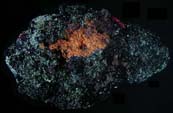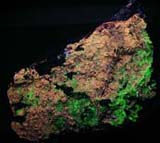 |
 |
 |
| Silver Hill 1 | Silver Hill 2 | Silver Hill 3 |
|
|
 |
 |
| Silver Hill 4 | Silver Hill 5 | Silver Hill 6 |
|
|
Silver
Hill is located northwest
of Magdalena, New Mexico and has primary prospects on the north and south side
along a vein that runs through the hill. The fluorescence at this locale
was first discovered by Dru Wilbur while he was working on a degree at the New
Mexico Institute of Mining and Technology in nearby Socorro. I expanded on his discovery by
searching all of the prospects and shafts in the surrounding area. In
addition to the original find of Calcite, Willemite, and Caliche I discovered
Aragonite, Hyalite Opal, and a few pieces of multi-colored Calcite.
The Kelly Mine, located near the small town of
Since collecting at the Kelly Mine has gone on already for over a hundred years I had little hope of finding such pieces. However, I figured that there was good chance that nobody had seriously searched there for fluorescents so it seemed worth a try. Indeed I found a number of interesting pieces, the highlights being Smithsonite that glows violet and associated Calcite that glows red. For some reason the red Calcite only occurs in association with the Smithsonite. Elsewhere in the mine the Calcite is the more typical orange color.
Another mineral I found there glows a creamy yellow color and occurs as a weathered coating. My initial identification was Aragonite but I became less sure when I noticed that there was little or no phosphorescence and also no response under midwave or longwave. This mineral, whatever it is, is quite different than the typical textured Caliche coating.
Bingham, New Mexico is so far in the middle of nowhere that the nearest feature is the Trinity Site, the location of the detonation of the first atomic bomb. There are many mines in the area with a broad array of fluorescent minerals including less usual ones like Smithsonite, Cerussite and red-fluorescing Barite.